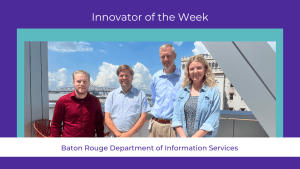Citizen academy wins city award for innovation

From left, Michael Stein, Senior GIS Analyst; Warren Kron, GIS Manager; Eric Romero, Director of Information Services; and Helen Frink, Community Outreach Coordinator.
Titles: Director of Information Services, GIS Manager, Senior GIS Analyst, and Community Outreach Coordinator
City: Baton Rouge/Parish of East Baton Rouge, La.
After the city of Baton Rouge/Parish of East Baton Rouge unveiled its open data portal in 2015, the Information Services team came to an unsettling realization; not only was the public not using the data, most residents weren’t even aware it existed.
The solution they found is called the Citizen Data Academy and it recently earned the department—including Michael Stein, Warren Kron, Eric Romero, and Helen Frink— the fourth-annual Sharman Stein award for Storytelling Changemakers. The award, which honors the memory of What Works Cities’ founding Director of Communications Sharman Stein, recognizes a city or county official or team that cultivates trust and collaboration between local government and residents through excellence in communications.
The award is given by Results for America, lead partner of What Works Cities, a Bloomberg Philanthropies initiative that helps cities use evidence and data to tackle their most pressing challenges.
Romero, Baton Rouge’s director of information services, said the academy—which includes a video series the department designed to show residents how to navigate and use the city/parish’s extensive data and analytics resources—grew out of an initial online session held at the beginning of the COVID-19 pandemic. “More and more people were embracing the virtual environment, ourselves included,” Romero says.
That initial session was followed by two more, all of which were much better attended than any of the team’s previous in-person sessions. Romero said the signs of interest sparked an idea: creating a permanent digital archive of tightly edited videos that show residents different ways to access and analyze data. Since its launch last year, the video series has had more than 13,000 views—whereas the pre-pandemic, in-person meetings to explain open data might sometimes draw just one or two residents. “We were lucky to get 30,” Romero says.
Kron, the GIS (Geographic Information System) manager for the city/parish, said the main goal that underlined all of their efforts was to engage residents. “If we're going to keep developing our applications and our technology, at some point, if our users aren't in tune with what we're doing, we're going to lose them. So, we have to keep them coming along with us.”
They now plan to make even more easily digestible videos and to engage with specific city/parish departments such as maintenance and emergency operations.
The key, the team says, is to make using the data easy for even the most tech-phobic resident. “It’s just a matter of finding people where they are,” says Frink, the department’s community outreach coordinator. “We sit in offices and understand this information, but it's really about breaking it down, making it available, and hand delivering it to the audiences to whom it is useful.”
Pro tip: “Keep thinking of your end user and prioritizing that experience.” (Frink)

